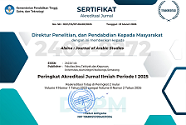Penerapan Ghinā’ ʿArabī sebagai Kegiatan Penunjang Giat Berbahasa Arab Siswa MTs NU Nurul Huda Semarang
DOI:
https://doi.org/10.21580/alsina.4.1.12294Keywords:
Arabic song, instructional media, language habituationAbstract
This article aims to describe the application of ghinā’ ʿarabī as an activity to support active Arabic language students at MTs NU Nurul Huda Semarang. The use of the ghinā’ method is considered more effective than other methods in supporting active Arabic students, especially for MI and MTs students. The method used in this study is a qualitative descriptive method. The data collection techniques were obtained through observation, interviews, and documentation. The application of ghinā’ ʿarabī to support the habituation of students' active learning at MTs NU Nurul Huda Semarang is very effective. Students become more enthusiastic and easier to understand and learn Arabic. This method also helps teachers in overcoming the lack of student focus in learning. In addition, students and teachers can also carry out teaching and learning activities in a conducive and fun way.
Downloads
References
Afroni, Mochamad, and A Barzan Lutfi. “Efektivitas Metode Bernyanyi dalam Penguasaan Mufradat Bahasa Arab di Kelas VII A Mambaul Ulum Tegal Tahun Pelajaran 2020/2021.” Jurnal Ilmiah Basrah 1, no. 2 (2021): 51–61. https://journal.stitpemalang.ac.id/index.php/bashrah/article/view/320.
Aghaei, Pouria, Mohammad Bavali, and Fatemeh Behjat. “An in-Depth Qualitative Study of Teachers’ Role Identities: A Case of Iranian EFL Teachers.” International Journal of Instruction 13, no. 2 (2020): 601–20. https://doi.org/10.29333/iji.2020.13241a.
Al-Khuli, Muhammad Ali. Strategi Pembelajaran Bahasa Arab. Translated by Hasan Saefuloh. Yogyakarta: BaSan Publishing, 2010.
Bokiev, Daler, and Lilliati Ismail. “Malaysian ESL Teachers’ Beliefs and Practices Regarding the Use of Music and Songs in Second Language Teaching.” The Qualitative Report 26, no. 5 (May 4, 2021). https://doi.org/10.46743/2160-3715/2021.4350.
Busse, Vera, Chantal Hennies, Gunter Kreutz, and Ingo Roden. “Learning Grammar through Singing? An Intervention with EFL Primary School Learners.” Learning and Instruction 71 (2021): 1–11. https://doi.org/10.1016/j.learninstruc.2020.101372.
Dewi, Yuli Ani Setyo. “Metode Pembelajaran Guru Etnis Jawa-Madura dalam Pengembangan Bahasa Siswa RA di Kabupaten Pasuruan.” SELING: Jurnal Program Studi PGRA 3, no. 2 (2017): 94–106. https://doi.org/10.29062/SELING.V3I2.122.
Ebedy, Hanan Gamal Mohamed Ebedy. “Using Songs in YouTube to Enhance EFL Students’ Pronunciation.” Occasional Papers in the Development of English Education 60, no. 2 (December 25, 2015): 51–82. https://doi.org/10.21608/opde.2015.77300.
Ghasemi, Babak, and Masoud Hashemi. “Foreign Language Learning During Childhood.” Procedia - Social and Behavioral Sciences 28 (2011): 872–76. https://doi.org/10.1016/j.sbspro.2011.11.160.
Good, Arla J, Frank A Russo, and Jennifer Sullivan. “The Efficacy of Singing in Foreign-Language Learning.” Psychology of Music 43, no. 5 (2014): 627–40. https://doi.org/10.1177/0305735614528833.
Horn, Dominique, Peyton Jennings, Tatiana Mcgraw, Peng Zhou, and Weiyi Ma. “Singing Facilitates Word Learning and Memory.” In Proceedings of the 44th Annual Boston University Conference on Language Development, edited by Megan M. Brown and Alexandra Kohut, 1:191–95. Somerville, MA: Cascadilla Press, 2020. http://www.lingref.com/bucld/44/BUCLD44-16.pdf.
Ludke, Karen M, Fernanda Ferreira, and Katie Overy. “Singing Can Facilitate Foreign Language Learning.” Memory & Cognition 42, no. 1 (2014): 41–52. https://doi.org/10.3758/s13421-013-0342-5.
Mahyudin, Erta. “Pengajaran Kosakata Bahasa Arab bagi Anak-Anak dengan Media Lagu.” MUTSAQQAFIN: Jurnal Pendidikan Islam dan Bahasa Arab 1, no. 1 (2018): 65–84. https://doi.org/10.46257/MUTSAQQAFIN.V1I01.26.
Nisa, Ika Khoirun, Novita Rahmi, and Wal Fajri. “Penerapan Metode Bernyanyi dalam Meningkatkan Penguasaan Kosakata Bahasa Arab di MTs MA’ARIF NU 07 Purbolinggo.” Arabia 12, no. 2 (2020): 43. https://doi.org/10.21043/arabia.v12i2.7878.
Satori, Djam’an, and Aan Komariah. Metodologi Penelitian Kualitatif. Bandung: Alfabeta, 2017.
Septiani, Vely. Penerapan Metode Bernyanyi dalam Pembelajaran Bahasa Arab di MTs Al-Hidayah Purwokerto Barat (Undergraduate Thesis) 2018. Purwokerto: IAIN Purwokerto, 2018. http://repository.iainpurwokerto.ac.id/3518/.
Slamet, Sofyan. “Penggunaan Metode Bernyanyi dalam Pembelajaran Mufrodat Bahasa Arab Kelas 7 MTS Ma’arif Suka Slamet Indramayu.” Syntax Idea 2, no. 11 (November 20, 2020): 953–61. https://doi.org/10.36418/syntax-idea.v2i11.731.
Syamsiar, and Asyikin. “Peningkatan Mufrodat dalam Pembelajaran Bahasa Arab dengan Metode Bernyanyi.” PENDAIS 3, no. 1 (2021): 46–62. https://uit.e-journal.id/JPAIs/article/view/1065.
Werner, Valentin. “‘Song-Advantage’ or ‘Cost of Singing’? A Research Synthesis of Classroom-Based Intervention Studies Applying Lyrics-Based Language Teaching (1972–2019).” Journal of Second Language Teaching & Research 8, no. 1 (2020): 138–70. https://doi.org/10.20378/irb-49313.
Downloads
Published
How to Cite
Issue
Section
License
Copyright
The copyright of the received article shall be assigned to the publisher of the journal. The intended copyright includes the right to publish the article in various forms (including reprints). The journal maintains the publishing rights to published articles. Authors are allowed to use their articles for any legal purposes deemed necessary without written permission from the journal, but with an acknowledgment to this journal of initial publication.
Licensing
In order for Alsina: Journal of Arabic Studies to publish and distribute research articles, the editors need publishing rights (transferred from author to publisher). This agreement relates to the transfer/publishing copyright license to Alsina: Journal of Arabic Studies but the authors still have significant rights to use and share their published articles.
Alsina: Journal of Arabic Studies supports the need for writers to share, disseminate and maximize the impact of their research and their rights on any database. As a journal article writer, you have the right to various uses of your articles, including that by the institution or company where you work. Copyright can be used without the need for special permission. Authors who publish articles in the Alsina: Journal of Arabic Studies have broad rights to use their work for teaching and scientific purposes without requesting permission, including:
- Use by the author for lectures, presentations, or conferences, with distribution of copies to participants;
- Distribution to colleagues for research use;
- Use in compilations of the author's subsequent work;
- inclusion in a thesis or dissertation;
- Reuse of sections or excerpts from articles in other works (with full acknowledgment of the final article);
- Preparation of derivative works (other than commercial purposes) (with full acknowledgment of the final article);
- Voluntary posting on open websites operated by authors’ or writers' agencies for scientific purposes
When submitting a manuscript, authors do so on the understanding that if accepted for publication, the copyright for publishing (publishing right) of the article shall be assigned/transferred to Alsina: Journal of Arabic Studies.
Authors whose articles are accepted for publication will receive confirmation via email and sent a Copyright Transfer Agreement.


 Accreditation
Accreditation 
 In Collaboration with
In Collaboration with 

 Visitors
Visitors  Article Template
Article Template





